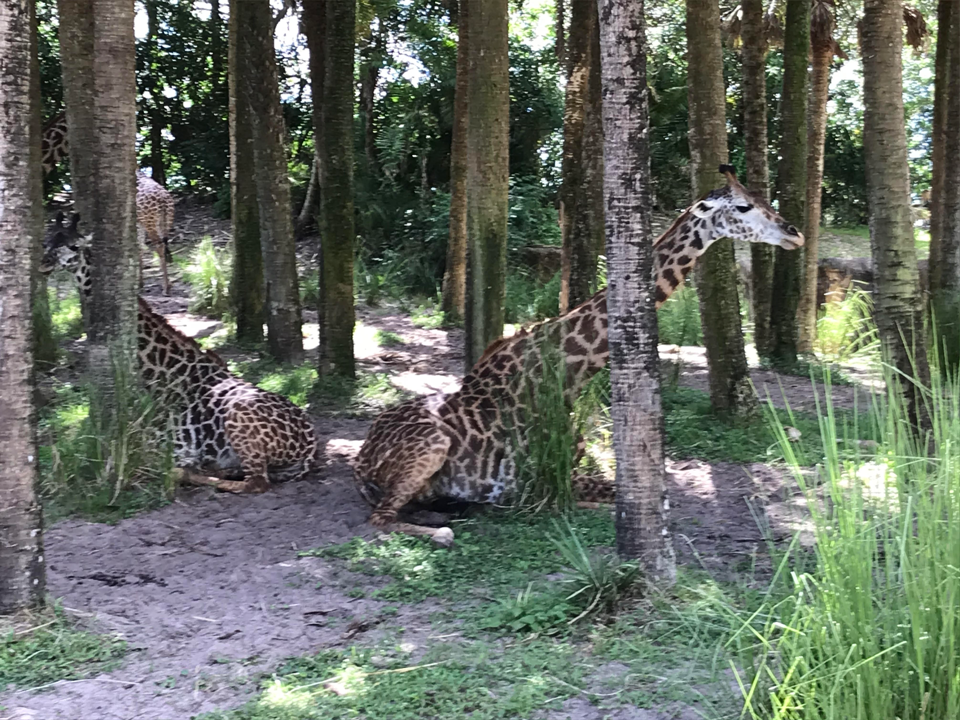Source: Disney Parks Blog
Part three of a series of articles takes us through the Harambe Wildlife Reserve in Animal Kingdom’s Kilimanjaro Safaris.
After traversing through the tranquil Little Ituri Forest and along the treacherous Safi River, we have now reached the savanna. This is an open plain bursting with life. As the journey onto the savanna begins, guests see the Baobab tree.
Safari guides make a point of ensuring visitors to the reserve take notice of this tree. Baobab trees are a crucial part of the savanna. They provide shelter for snakes, bats, bees, and more. Storing water in arid ecosystems, elephants and other large animals will chew on the bark, harming the Baobab. Animals and humans eat the trees, fruits, and seeds. Fruit is high in calcium, minerals, and antioxidants. The Tree of Life in the center of Animal Kingdom is modeled after the Baobab, referred to by that name in some parts of Africa. Researchers study the tree that lives in Africa’s dry savannas, Madagascar, and Australia. Drought, mold, fungus, and animals eating the bark put the tree at risk in many locales, but it is a key to the savanna’s ecosystem.
Giraffes are probably the most prominent animal on Kilimanjaro Safaris, and they never fail to impress. The world’s tallest land mammal, they often get incredibly close to vehicles causing “giraffic jams.” Baby giraffes, starting at about six feet in height, are a frequent sight on the savanna, and they reach their full size at about age four. Masai giraffes found on the savanna are an orange-brown color, and they are the darkest species. In past years, I believe I have seen both Masai and Reticulated giraffes on the savanna. If it is now exclusively Masai, one can still see Reticulated giraffes at Animal Kingdom Lodge. Sitting down puts giraffes on African savannas at risk of attack from predators; therefore, actually sitting is rare. This behavior is not unusual on Animal Kingdom’s savanna, confirming they feel safe and comfortable in the reserve.

Wildebeest are unique-looking animals with curved horns, a heavy front end, and spindly legs. About %80 of wildebeest calves are born in the same two to three-week period. Guides on the Safari mention their migration, which tracks the rains around a thousand-mile loop. Through the Serengeti in Tanzania and up to the Masai Mara National Reserve in Kenya, their migration includes over 1.5 million wildebeest, tens of thousands of zebras, and other antelope. No conflict exists between the wildebeest and zebra, who eat different parts of the same grass. Eating grass and keeping it short helps prevent the spread of fires. The first episode of Great Migrations on Disney+ shows the harsh realities of their migration.

Painted dogs or African wild dogs live in their own enclosure to the left of the Safari vehicle, joining the savanna in December 2015. Absolutely gorgeous with large round ears and paint-like splotches, they have bushy white-tipped tails. Mostly due to habitat fragmentation, their populations are in serious decline, and they are among the most endangered mammals on earth. Introducing them to Animal Kingdom helps to raise awareness of the species. Since 1996 the Disney Conservation Fund has provided monetary support to organizations looking to conserve and study these beautiful animals.

Packs ranging from seven to fifteen and even to 40 members all care for each other, caring for pups and sharing food. Every time the pack wakes up and returns from a hunt, they try to interact with each other in elaborate ceremonies. Each dog has unique squeals and yips.
Termite mounds exist throughout the savanna, and while termites are a serious pest to probably everyone reading this, they are crucial to this habitat. On African and Australian savannas, they eat dead plant material, cleaning habitats and cycling nutrients. Mounds up to 16 feet in height are constructed from the soil, saliva, and dung. Porous the structures have tunnels and passages allowing air to travel easily up through a central chimney. Constant air circulation keeps the mound cool and ensures oxygen permeates to the lower chambers. Termites generally exit through several tunnels at the base of the mound at night, when it is cooler to forage.
While active, termites are frequently eaten by many animals, and seeds will germinate in and on the structures. Monitor Lizards will lay their eggs inside of them, as the temperature is perfect. Once colonies die out, animals on the savanna move in. Birds nest, snakes hibernate, dogs and hyenas create dens, and warthogs sleep in the now-vacant mounds. Storing nutrients and moisture in the tunnels better hydrates the soil, and therefore vegetation flourishes around the mounds. This help keeps dry grassland and savanna from becoming barren desert.

Hartmann’s Mountain Zebra live in the Reserve, and similar to giraffes, babies are not an unusual sight. Zebra foals are born with legs almost as long as an adult’s and can run within 20 minutes of birth. Kicks from their hind legs can easily break the jaws of predators, and the zebra can run almost 40 miles per hour. Episode three of Magic of Disney’s Animal Kingdom on Disney+ shows the viewers details of the zebra’s care and life on the savanna.
Ankole cattle, distinguished by their giant horns, can be traced to ancient Egypt, and today they are common in countries like Uganda and Rwanda. Hardy animals can survive on little food and water if needed. Generally, they weigh between 1,000 and 1,500 pounds but can run and jump with an impressive agility as needed. The domesticated species has meat low in fat and cholesterol, and its milk is high in fat, making it useful for butter and yogurt production.
Three breeds of antelope populate the savanna. Patterson’s Eland is one of the world’s largest antelope. Eland have a light brown coloring and long horns. Calm and easy to domesticate, their milk is rich in protein and fat. Weighing in at 1,300 to 2,200 pounds, meaty bodies make them prime targets for illegal hunters. In September 2019, a calf named Doppler was born; named in honor of its post-Hurricane Dorian birth. Sable antelope are much darker than the Eland and lighter at about 485 to 525 pounds. Calves are reddish-brown; as they age, they darken and develop white markings. Their appearance becomes more striking as they age. They grow horns between 21 and 60 inches in length. Three calves born in the Summer of 2011 joined the herd on the savanna in November 2011. They were kept backstage for about two months so the animal care team could properly monitor them. Otherwise, sable moms will “tuck” the calves in tall grass, shielding them from predators. Between December 2014 and January 2015, three male and two female calves were born, leading to three generations of Sable antelope on the savanna. The Sable antelope is the symbol of the Harambe Wildlife Reserve. Much smaller (weighing about 100 pounds), Springbok live in southwestern Africa in countries like Namibia, Botswana, and Angola. The Springbok is the national animal of South Africa and gets its name from jumping displays, referred to as the pronk. Springbok can run alongside their mother within an hour of birth, and when it tires, they will flatten and lay in high grass, shielding them from predators.

For many reasons, I recommend enjoying Kilimanjaro Safaris and getting back on immediately at Rope Drop (park opening). Focusing on specific animals in the savanna is especially difficult with so much going on. When a baby zebra is hopping along, or a giraffe is feet away, it is hard to observe the Springbok. If crowds are lower, going on the attraction a second time with a minimal wait should be possible. I even like to go on one journey with a camera ready and the next with no technology in hand. Otherwise, it is extremely difficult to enjoy all the savanna has to offer.
We shall next travel through Elephant country and the mud pits.
Do you have a favorite animal in the Savanna? Please feel free to leave a comment!

